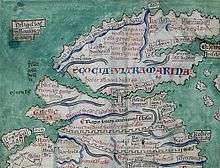Kingdom of Cat

Cait or Cat was a Pictish kingdom (25–871 AD)[1] during the Early Middle Ages. It was centred in what is now Caithness in northern Scotland. It was, according to Pictish legend, founded by Caitt (or Cat), one of the seven sons of the ancestor figure Cruithne. For a period of time Cait was the largest of the northern Pictish kingdoms, but its power waned over time. After the death of its last king, Taran mac Entifidich, in 697, it was absorbed into the broader Pictish kingdom.
The name is preserved in the modern placename Caithness, which occupies approximately the same location as the ancient kingdom. The name is also preserved in the Gaelic name for Sutherland (Cataibh), in several specific names within that county and in the earliest recorded name for Shetland (Inse Catt, meaning "islands of the Cat people").[2]
Watson (2005) compares this usage with the early Irish Innse Orc (islands of the boars) for Orkney and concludes that these are tribal names based on animals.[2]
Legends of Clan Chattan (pronounced cattan) suggest that Madoc (a Dalriadic Pict of Royal line) the father of St Chattan, had retreated to Dál Riata after losing Cat to the Norse. Thus Clan Chattan or Caitt-an is recognised by the Lord of the Isles as being of Pictish descent when he ratifies the Clan Chattan document (lost 1666).
See also
Notes
- ↑ "Early Kingdoms of Scotland". 2013. Regnal Chronologies. Retrieved 18 May 2014.
- 1 2 Watson (2005) pp. 29-30
References
- Watson, William J. (1994) The Celtic Place-Names of Scotland. Edinburgh. Birlinn. ISBN 1-84158-323-5. First published 1926.
